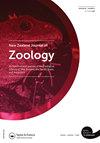评估困在活陷阱中的蜥蜴被捕食的风险
IF 1.1
4区 生物学
Q3 ZOOLOGY
引用次数: 1
摘要
活体诱捕(如陷阱诱捕或漏斗诱捕)是一种重要的小型陆生动物取样工具,是新西兰调查和监测陆生蜥蜴的主要方法之一。由于它会导致动物禁闭,因此使用活体诱捕的方法必须减轻对动物福利的风险。觅食的捕食者可以杀死或伤害被困在陷阱中的动物(例如蜥蜴);然而,人们对各种掠食性哺乳动物的造访率了解甚少,报道的事件大多是轶事。在一次蜥蜴打捞行动中,我们观察到一只老鼠在陷阱中捕食一只石龙子,我们记录了24小时内老鼠从陷阱中取出诱饵(梨)的情况,并安装了运动探测摄像机来记录老鼠到陷阱的情况。在观察期间,饵料迅速丢失,24 h后有77%的鼠类被清除。发现有3种啮齿动物到访捕鼠器,其中1只船鼠(Rattus Rattus)进入捕鼠器并取出饵料。我们建议在进行活捕时应考虑捕食者的密度,并认真监测和报告陷阱干扰。进一步的研究应该检查不同的诱捕方法(例如,捕食者专用的陷阱设计、诱饵和陷阱检查的时间)如何降低被诱捕动物被捕食的风险。本文章由计算机程序翻译,如有差异,请以英文原文为准。
Evaluating the risk of predation for lizards constrained in live traps
ABSTRACT Live trapping (e.g. pitfall trapping or funnel trapping) is an important sampling tool for a wide range of small terrestrial animals and is one of the predominant methods for survey and monitoring of terrestrial lizards in New Zealand. As it results in the confinement of animals, methods using live trapping must mitigate risks to animal welfare. Foraging predators can kill or injure animals confined in pitfall traps (e.g. lizards); however, visitation rates of various predatory mammals are poorly understood and reported occurrences are largely anecdotal. Following an observation of a rat depredating a skink in a pitfall trap during a lizard salvage operation, we recorded the removal of bait (pear) from traps over a 24-h period and installed motion-detecting cameras to record trap visitation. Bait loss occurred rapidly over the observed period, with 77% removed after 24 h. Three rodent species were detected visiting a trap, with one ship rat (Rattus rattus) entering it and removing the bait. We suggest that operations involving live trapping of lizards should consider predator densities and carefully monitor and report trap disturbance. Further research should examine how different trapping methods (e.g. predator-exclusive trap design, baiting, and timing of trap checks) might reduce the risk of predation to trapped animals.
求助全文
通过发布文献求助,成功后即可免费获取论文全文。
去求助
来源期刊
CiteScore
2.80
自引率
0.00%
发文量
20
审稿时长
>12 weeks
期刊介绍:
Aims: The diversity of the fauna of the southern continents and oceans is of worldwide interest to researchers in universities, museums, and other centres. The New Zealand Journal of Zoology plays an important role in disseminating information on field-based, experimental, and theoretical research on the zoology of the region.

 求助内容:
求助内容: 应助结果提醒方式:
应助结果提醒方式:


